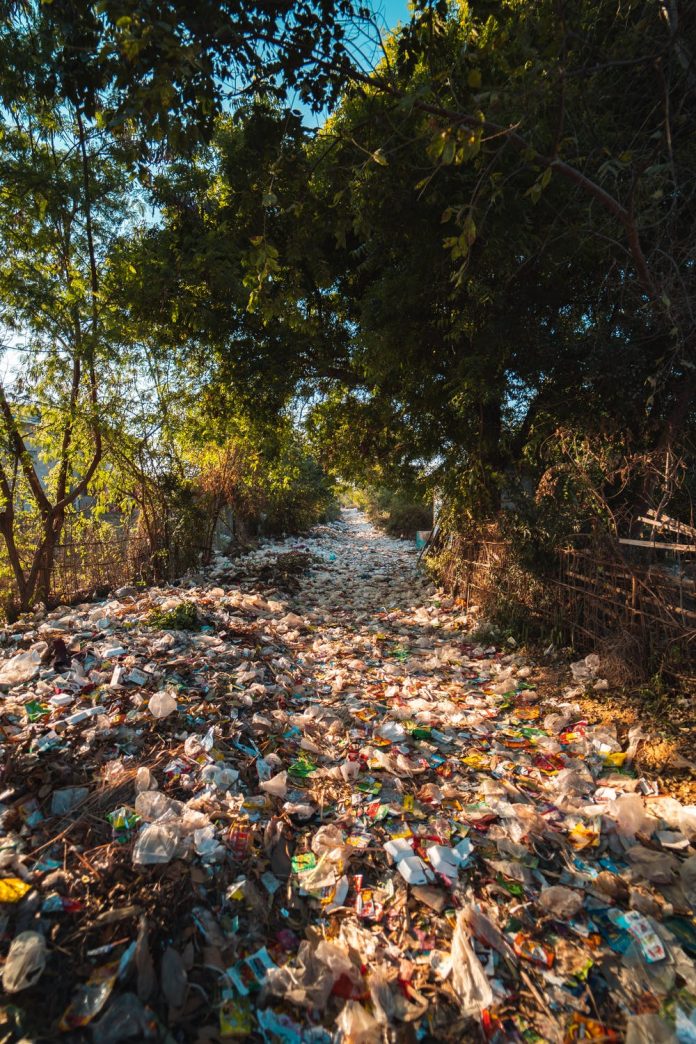According to a UNEP report, over 60 nations have some type of regulation — ban or taxes — on the creation and use of plastic. In any case, implementation has not been vigorous, and just about 30 percent of the nations reported a drop in utilization. India’s record in actualizing plastic bans has been poor. However, by raising the pitch on plastic use, the legislature is wanting to make more manufacturers go along to regulations.
In June 2018, Prime Minister Narendra Modi announced that India would eliminate single-use plastics by 2022.
India generated 26,000 tons for each day (TPD) of plastic waste in 2017-18, the latest year for which data is available, according to the Central Pollution Control Board. Of that, 15,600 TPD, or 60 percent, was reused. The rest wound up as litter on roads, in landfills, or streams. Uncollected plastic waste represents an enormous threat to animal varieties on land and in water.
Around 8,000,000 tons of plastic waste enter the ocean consistently. The waterway Ganga alone took 1.15 lakh tons of plastic into the ocean in 2015, second just to China’s Yangtze, according to a research paper distributed in Nature Communications magazine.
India’s plastic reusing rate is 60 percent, multiple times higher than the global average of 20 percent, and India’s per capita plastic utilization — at 11 kg in 2014-15 — is not exactly half the global average of 28 kg.
The Issue: Since half the plastic presently created is meant to be used just a single time, India must make sense of what plastic it wants to use and ban — and how it will reuse all that trash.
India lacks an organized framework for the management of plastic waste, leading to widespread littering across its towns and urban areas.
The ban on the initial six things of single-use plastics will cut 5% to 10% from India’s annual utilization of about 14 million tons of plastic, the principal official said.
Penalties for violations of the ban will probably take impact after an initial half year duration to allow individuals time to adopt alternatives, officials said.
Some Indian states have already outlawed polythene bags.
The federal government also plans tougher environmental standards for plastic items and will demand the use of recyclable plastic just, the principal source said.
It will also ask online business companies to curtail plastic packaging that makes up nearly 40% of India’s annual plastic utilization, officials say.
Use and Reuse
A key advance toward that path was Extended Producer Responsibility (EPR) under the Plastic Waste Management Rules, 2016, which were amended last year. As part of EPR, makers, shippers and brand proprietors — like fast-moving shopper merchandise (FMCG) and pharma companies — should take back the plastic waste generated by their items, with the assistance of waste-management companies
Companies are attempting to move to single-polymer packaging, which would make it recyclable.
The Challenge: While India is one of 63 nations with EPR, its rules for the same keep on being vague. There isn’t a lot of clarity on the amount of single-use plastic a company puts out should be taken back by it.
There is no mechanism to execute EPR. Regardless of whether the administration decides to ban certain plastics, there is a central issue mark on how compelling it will be. Plastic is cheap and advantageous, and if there is a demand for it, individuals are going to manufacture it.
In contrast to urban local bodies, gram panchayats may not have the assets to do routine minds plastic use. Maharashtra is among the 23 states that have completely or partially banned plastic bags, however, that has not stopped individuals from utilizing them.
The cigarette butt is the most generally discovered litter on beaches and in streams and lakes. A global coastal clean-up drive in 2018 discovered 5.7 million of them.
Plastic waste management
The Plastic Waste Management Rules, 2016 of the Center has called for a ban on “non-recyclable and multi-layered” packaging by March 2018, and a ban on carrying bags of thickness under 50 microns (which is about the thickness of a strand of a human hair). The Rules were amended in 2018, with changes that activists say favored the plastic business and allowed manufacturers an escape course. The 2016 Rules didn’t refer to SUPs.
Single-use plastic alternatives
There is no viable alternative as of now for single-use plastic things. The alternative to single-use plastic things, especially single-use plastic containers, which are used to sell packaged drinking water, should be affordable for the buyers. A drinking water bottle, which costs Rs 20 at present, cannot be estimated higher than that. Further, customers have indicated trust in the sealed water bottles throughout the years and consequently, the alternative ought to also be sufficient.
Since reusing plastic is anything but a permanent arrangement, manufacturers of single-use plastic have been asked to search for different alternatives that are biodegradable. Railway service, which manufactures and sells packaged drinking water ‘Rail Neer’ is also searching for alternatives including polymers to make their packaging biodegradable.
Are alternatives, for example, compostable or biodegradable plastics viable?
Although compostable, biodegradable, or even eatable plastics made from various materials, for example, bagasse (the buildup after extracting juice from sugarcane), corn starch, and grain flour are advanced as alternatives, these right now have limitations of scale and cost.
Some biodegradable packaging materials require explicit microorganisms to be separated, while compostable cups and plates made of polylactic acid, a popular asset got from biomass, for example, corn starch, require industrial composters. Then again, articles made through an alternate procedure including potato and corn starch have improved in normal conditions, passing by the involvement with Britain. Seaweed is also rising as a decision to make palatable containers.
In India, however, in the absence of vigorous testing and certification to check claims made by makers, false biodegradable and compostable plastics are entering the marketplace.
A ban on single-use plastic things would have to along these lines lay down an extensive mechanism to affirm the materials marketed as alternatives, and the particular procedure required to biodegrade or compost them. A development against plastic waste would have to organize the decrease of single-use plastic, for example, multi-layer packaging, bread bags, food wrap, and defensive packaging. Purchasers regularly have no decision in the matter. Different parts of the campaign must concentrate on tried biodegradable and compostable alternatives for plates, cutlery, and cups, thorough segregation of waste, and scaled up reusing. City municipal authorities play a key job here.
The Way Ahead – How to dispose of the plastic menace?
Leading a grassroots development to help the adoption of a global framework to regulate plastic contamination.
Educating, assembling, and activating residents across the globe to demand that legislatures and corporations control and clean up plastic contamination.
Educating individuals worldwide to take personal obligation regarding plastic contamination by deciding to dismiss, lessen, reuse, and reuse plastics.
Advancing local government regulatory and different endeavors to tackle plastic contamination.
Education and obligation are just one side of the coin, notwithstanding; the opposite side is infrastructure. The innovation to create a circular economy through reusing does exist, however, the infrastructure expected to completely actualize it is genuinely lacking. Of all the plastic waste delivered on the planet, under 10% is recouped due in large part to the lack of infrastructure both at home and abroad.









It’s really a cool and helpful piece of info. I’m happy that you just shared this helpful information with us.
Please stay us up to date like this. Thanks for sharing.
Thank you
There is obviously a bunch to realize about this. I assume you made some nice points in features also.
Thank you so much
I am constantly invstigating online for articles that can aid me. Thx!
Hullo, just become aware of your post through Bing, and located that its truly informative. I’m going to be careful for brussels. I’ll appreciate should you proceed this in future. Many other people will probably be benefited from your writing. Thankx
Thank you so much
Hey there! I know this is kinda off topic nevertheless I’d figured I’d ask. Would you be interested in trading links or maybe guest writing a blog post or vice-versa? My blog discusses a lot of the same subjects as yours and I think we could greatly benefit from each other. If you might be interested feel free to send me an e-mail. I look forward to hearing from you! Fantastic blog by the way!
Thanks for the post.
Thanks for another fantastic article. I have a presentation next week, and I’m at search for such info.
It’s a pity you don’t have a donate button! I’d most certainly donate to this superb blog! I guess for now i’ll settle for bookmarking and adding your RSS feed to my Google account. I look forward to fresh updates and will talk about this site with my Facebook group. Talk soon!
whoah this blog is fantastic i love reading your posts. Keep up the good work! You know, many people are searching around for this info, you could help them greatly.
Thank you
Oh my goodness! an amazing article dude.
Thank you
There is noticeably a bundle to know about this. I assume you made certain good points in features also.
Hey there, You have done an excellent job. I’ll certainly suggest this website to my friends. I’m sure they’ll be benefited from this site.
Thanks for the helpful posting.
I just couldn’t depart your website before suggesting that I extremely enjoyed the information you provided for your visitors. I am gonna be back often in order to check up on new posts
Thank you
Your mode of explaining the whole thing in this article is genuinely pleasant, all can without difficulty be aware of it, Thanks a lot.
my page: tracfone special
Oh my goodness! Awesome article dude! Thanx!!
I really enjoyed reading your post. It helped me a lot and I hope it can help others too.
Thank you
Please tell me more.
You’ve been terrific to me. Thank you!
Welcome
Thank you for writing this article!
Welcome
I always find your articles very helpful. Thank you!
Welcome